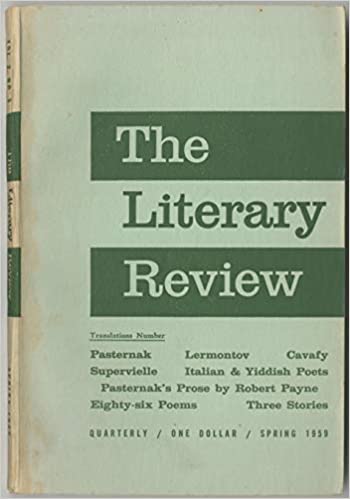1957- today
New Jersey, USA
Born within Fairleigh Dickinson University that still publishes it today, the quarterly magazine The Literary Review, has trespassed the university context to address a larger American and transnational audience.
Since its first publication in 1957, the Review has distinctly shown its international slant. The editors Charles Angoff and Clarence R. Decker announced their ambitious project of publishing foreign authors in every issue, preferring most unreleased translations, and of dedicating periodically special issues to the contemporary literature of foreign countries.
Italian literature is celebrated on many occasions in the first volumes. Poetry predominates, but texts in prose, essays, and explanatory notes are also present. In the very first number, Charles Norman pays homage to his friend and poet Francesco Bianchi, recently passed away in New York and unpopular in Italy. The second special issue about foreign literature is devoted to contemporary Italian literature (vol. III, no. 1, autumn 1959). Edited in collaboration with Elémire Zolla and Ferdinando Virdia, it features only contemporary authors, such as Italo Calvino, Giorgio Bassani, and Carlo Cassola for fiction and Attilio Bertolucci, Mario Luzi, and Pier Paolo Pasolini for poetry. Nicola Chiaromonte, Giacinto Spagnoletti, and Claudio Gorlier gave their contribution by writing essays about the state of Italian theatre, prose, and literary critique in post-war Italy. Illustrations by Giuseppe Viviani, Marino Marini, and Mino Maccari embellish the volume. In the opening editorial notes, Angoff and Decker acknowledged the importance of the Italian tradition for English-language literature, thus motivating the presence of old texts in other issues, such as Michelangelo and Machiavelli’s poetry translated by Joseph Tusiani (vol. III, no. 3, 1960; and vol. VI, no. 3, 1963).
Over the years, the Review displayed the first translated works by Zolla and Domenico Rea, and introduced Anna Banti and Gianna Manzini to the American readers, thus devoting space to women. Indeed, Anna Maria Ortese, Maria Luisa Spaziani, and Elsa Morante add to the above-mentioned women writers. Among poets, Salvatore Quasimodo is the most represented, together with authors already known to the American readers such as Eugenio Montale, Giuseppe Ungaretti, Vittorio Sereni, Sandro Penna, as well as the less famous Carlo Betocchi, Raffaele Carrieri, Libero De Libero, Ugo Fasolo and Alfonso Gatto.
In 1963, Angoff and Decker celebrated foreign narrative in the collection Modern Stories from Many Lands (Manyland Books, 1963) where the best short stories printed until then appear. In the fifteenth anniversary of The Review in 1972, a second revised and expanded edition was published. Remarkably, “Armida and Reality” by Ennio Flaiano, "A Siberian Shepherd's Report of the Atom Bomb" by Dino Buzzati, and “The Sicilian Soldier” by Morante were re-proposed, selected as the highest expression of Italian fiction.
Among the contributors of the magazine, there were many scholars of Italian origins, such as Olga Ragusa and Rosina Cancellieri who translated some works in prose, and Peter Sammartino, advisory editor of TLR and co-founder of Fairleigh Dickinson University. Main translators for fiction were John Fischer and Josephine P. Ferrante, while Willard Trask and Eric Sellin were the most active in the field of poetic translations. Moreover, Sellin edited the section about Italian poetry both in the second and third volume, the latter in collaboration with Charles Guenther.
The positive influence of the magazine is undeniable, the enthusiastic reviews of the time demonstrate its large spread and its high cultural implication. The Literary Review significantly contributed to the dissemination of Italian culture in the English-speaking world. Two events recounted in the notes of the third volume (no. 3, 1960) attest its wide appeal to the general public. The TV channel 9 (KETC) broadcast a discussion of the Italian number of the Review, in the presence of Charles Guenther, who also attended the meeting held at St. Louis Public Library about the Italian poems present in the second issue of that same year (vol. III, no. 2, 1959).
Related Vectors
Pier Paolo Pasolini
Writer, director, actor, painter
Tusiani Joseph (Giuseppe)
poet, academic, translator
Giuseppe Ungaretti
Poet, Writer, Translator
Nicola Chiaromonte
Author and Activist
Sources
Decker, Clarence Raymond, and Charles Angoff. Modern Stories from Many Lands. New York: Manyland Books, 1972.
Fairleigh Dickinson University. The Literary Review, vol. I - XX. Madison: Fairleigh Dickinson University Press, 1957-1977.
Green, Martin. "Twenty-five Years of The Literary Review." The Literary Review, vol. 25, no. 4 (Summer 1982): 484.
Green, Martin. "The Literary Review and Its Founders." The Literary Review, vol. 50, no. 4 (Summer 2007): 10.
Healey, Robin. Italian Literature since 1900 in English Translation: An Annotated Bibliography, 1929-2016. Toronto: University of Toronto Press, 2019.






